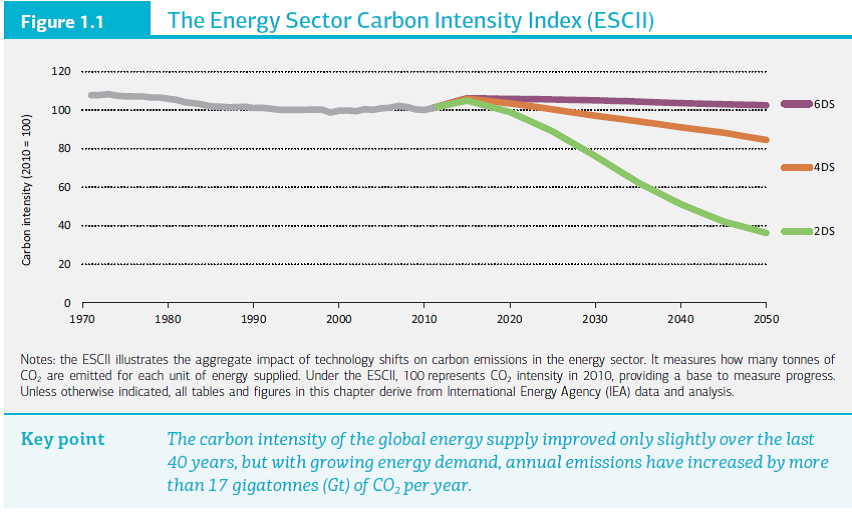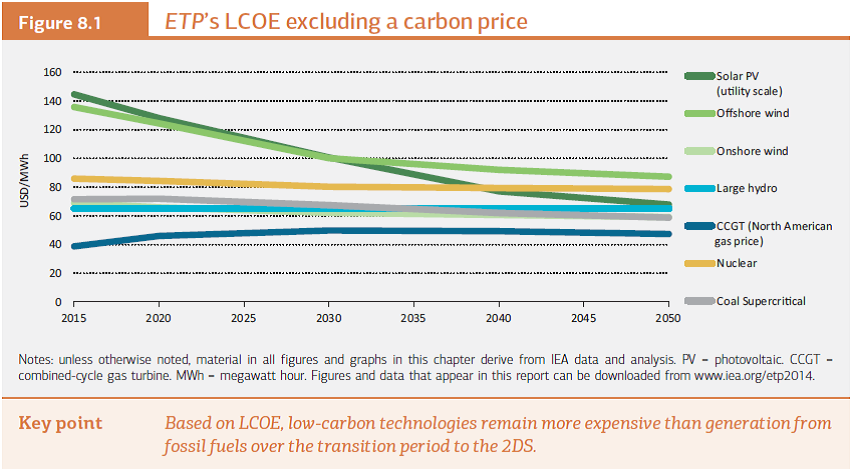As a solution for climate change – nuclear power is falling behind
Recently, the 2014 edition of the International Energy Agency’s (IEA) Energy Technology Perspectives (ETP) was issued. The ETP is issued on a two year cycle; the current edition takes the World Energy Outlook 2013 forecasts and looks to the longer term out to 2050. With climate change now becoming even more pressing I thought it would be interesting to see the progress over the last two years (I wrote about the 2012 edition back in June of that year). According to the report, as an important contributor to meeting climate requirements going forward, nuclear power is falling behind.
On the positive side, the IEA sees the opportunity by which “policy and technology together become driving forces – rather than reactionary tools – in transforming the energy sector over the next 40 years.” The report looks to balance energy security, costs and energy-related environmental impacts. But in the end it concludes that “Radical action is needed to actively transform energy supply and end use. ”
Why is radical action required? Of all the technologies required to meet the 2D target (this scenario sets a target of only 2 degrees C change as compared to 6 degrees in the status quo scenario), the IEA suggests that only renewables are on track while pretty much every other clean technology is not moving fast enough. Two important technologies not meeting targets are Carbon Capture and Storage (CCS) and Nuclear Power. To no one’s surprise, CCS has yet to be proven and become a viable commercial option to de-carbonize fossil fuel emissions. As for nuclear power; after the Fukushima accident, growth has been slower than previously predicted and is expected to be 5 to 25% below the level required by the 2D scenario in 2025.
This leaves much of the burden on renewables to meet the need for lower carbon emissions. Surprisingly, in the hi-renewables scenario, solar becomes the dominant source of electricity reaching 40% penetration by 2050. Realistic or pipe dream? I don’t know. One thing is certain, (see chart below), with almost half of future electricity generation coming from variable renewables, compared to almost nothing today, the IEA is demonstrating the need for a huge technology transformation in how the world generates electricity.
The following chart is the most telling of all. Over the past 40 years carbon intensity (the amount of carbon emitted per unit of energy supplied) has barely budged. Almost no change at all. Yet now we require the carbon intensity to be cut in half in the next 35 years (meaning less than half as much carbon produced per unit of energy supplied). This requires a complete change in how energy is delivered.
The reason is simple. Fossil fuels still represent 80% of global electricity generation and most of the energy used for transport. To disrupt the curve requires going off fossil fuels to cleaner alternatives. To achieve the 2D scenario, electrification is paramount given the option of generating electricity with clean alternatives. Fossil fuel use must then be cut in half to about 40% of electricity generation and much of the remainder makes use of CCS to reduce its carbon footprint. The report notes that gas must only be a bridging technology to support renewables in the short to medium term as gas still represents a major carbon source. So what’s left? Solar and wind to replace fossil fuels and CCS to make them cleaner.
Of course nuclear power is an obvious candidate to make a larger contribution. It is a mature technology and already is an important source of low carbon energy. Given its energy intensity it is certainly feasible to implement more nuclear power on a very large scale. And even with recent set-backs, there are now clear signs of renewal as the industry puts the Fukushima accident behind it.
For example, China continues to expand nuclear power at an ever increasing pace. Japan has reconfirmed its commitment to nuclear although restarts are slower than anticipated and the ultimate level of nuclear in post-Fukushima Japan remains unknown. Russia is increasing its commitment to nuclear and, of most interest, is becoming a major exporter offering innovative risk and financing structures that have not been seen in the market to date. Other markets are also starting to move; the latest being Hungary which has just approved a new plant for the PAKS site. However some other important nuclear markets are having challenges. Korea has cut back its long term plans and France is looking to limit the contribution of nuclear power in the future.
While nuclear power has challenges with public acceptance, this report notes the commercial issues – economics and implementation risk. As can be seen in the following chart, the IEA estimates nuclear to be the most expensive option after off-shore wind. I have not had time to delve into the details and review the numbers. However, taking this at face value, we know that some projects in the west are not doing as well as they should be. On the other hand, standardized series-build in countries like China and Russia are demonstrating a strong path to lower project costs and risks.
There is no hi-nuclear scenario in this edition of the report. That is quite unfortunate as a strong renewed commitment to nuclear power is a very good way to help move this plan to achieve a 2D future become a reality. By stating that nuclear power is not meeting expectations, the report lays out a clear challenge. Now it’s time to show the nuclear industry is up to it. If we really want to bend the carbon intensity curve, then more than ever, the world needs more nuclear power as an important part of a low carbon future.


